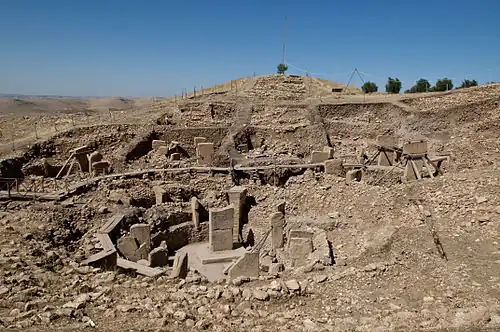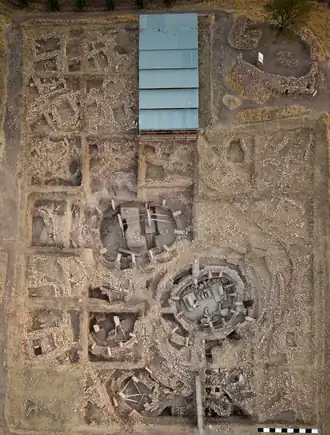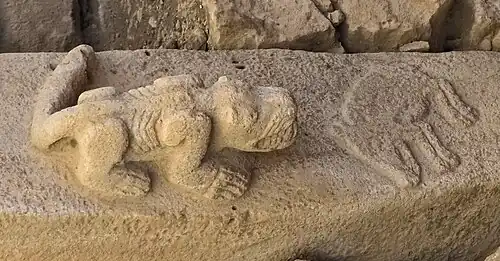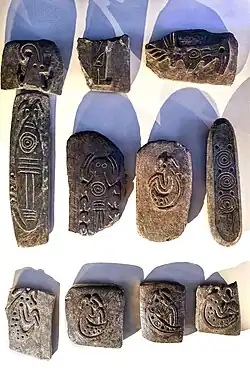Pre-Pottery Neolithic A
 The ruins of Göbekli Tepe, c. 9,000 BCE The ruins of Göbekli Tepe, c. 9,000 BCE | |
| Geographical range | Near East |
|---|---|
| Period | Pre-Pottery Neolithic |
| Dates | c. 10,000 – c. 8,800 BCE[1] |
| Type site | Jericho |
| Preceded by | Khiamian, Harifian |
| Followed by | Pre-Pottery Neolithic B, Neolithic Greece, Faiyum A culture |
Pre-Pottery Neolithic A (PPNA) denotes the first stage of the Pre-Pottery Neolithic, in early Levantine and Anatolian Neolithic culture, dating to c. 12,000 – c. 10,800 years ago, that is, 10,000–8800 BCE.[1][2][3] Archaeological remains are located in the Levantine and Upper Mesopotamian region of the Fertile Crescent.
The time period is characterized by tiny circular mud-brick dwellings, the cultivation of crops, the hunting of wild game, and unique burial customs in which bodies were buried below the floors of dwellings.[4]
The Pre-Pottery Neolithic A and the following Pre-Pottery Neolithic B (PPNB) were originally defined by Kathleen Kenyon in the type site of Jericho, State of Palestine. During this time, pottery was not yet in use. They precede the ceramic Neolithic Yarmukian culture. PPNA succeeds the Natufian culture of the Epipalaeolithic Near East.
Climate changes

Pre-Pottery Neolithic A, with representative cultures such as Taş Tepeler, belongs to the broad movement of the Neolithic revolution in the Fertile Crescent, a process over several millennia, which witnessed many changes in the areas of settlement density and population, architecture, agriculture, lithic constructions and art.[6] The innovations of the Pre-Pottery Neolithic A culture constituted a sharp progress compared to the earlier Natufian culture, especially in terms of art and monumentality, in a sense marking the "origin of civilization".[6]
These changes seem to be corelated to climate evolutions, with the advent of the Younger Dryas and the start of the current Holocene once climate had stabilized.[6] Such climate changes may have been the "trigger" that led to the development of the monumentality of Pre-Pottery Neolithic A sites as the Taş Tepeler group.[6] By generating awe and stimulating inquiry, climatic changes may have accelerated profound changes in cognition and mythological speculations that were already at play since the Palaeolithic.[6]
Settlements

One of the earliest known Pre-Pottery Neolithic sites is Körtik Tepe in Upper Mesopotamia, starting in the Younger Dryas period in cal. 10,687 BCE ± 78 years.[7][8] Gesher, in modern Israel, is also one of the earliest known Neolithic sites (PPNA), with a calibrated Carbon 14 date of 10,459 BCE ± 348 years, analysis suggesting that it may have been the starting point of a Neolithic Revolution.[9] A contemporary site is Mureybet in modern Syria.[9]
PPNA archaeological sites are much larger than those of the preceding Natufian hunter-gatherer culture, and contain traces of communal structures, such as the famous Tower of Jericho. PPNA settlements are characterized by round, semi-subterranean houses with stone foundations and terrazzo-floors.[10] The upper walls were constructed of unbaked clay mudbricks with plano-convex cross-sections. The hearths were small and covered with cobbles. Heated rocks were used in cooking, which led to an accumulation of fire-cracked rock in the buildings, and almost every settlement contained storage bins made of either stones or mud-brick.
One of the most notable PPNA settlements is Jericho, thought to be the world's first town (c. 9,000 BCE).[11] The PPNA town contained a population of up to 2–3000 people and was protected by a massive stone wall and tower. There is much debate over the function of the wall, for there is no evidence of any serious warfare at this time.[12] One possibility is the wall was built to protect the salt resources of Jericho.[13] It has also been proposed that the tower caught the shadow of the largest nearby mountain on summer solstice in order to create a sense of power in support of whatever hierarchy ruled the town's inhabitants.[14]
-
 Reliefs of animals, Göbekli Tepe Layer III (Pre-Pottery Neolithic A), c. 9000 BCE.
Reliefs of animals, Göbekli Tepe Layer III (Pre-Pottery Neolithic A), c. 9000 BCE. -
![The Urfa Man c. 9000 BCE.[15][16][17] Şanlıurfa Archaeology and Mosaic Museum.](./_assets_/Urfa_man.jpg)
-
![Karahan Tepe anthropomorphic statue (2.3 meters), naked and holding phallus with both hands. 10,000-9,500 BC.[18]](./_assets_/Porthole_Stone_and_Phallic_Statue_(Side)%252C_Area_08%252C_Karahantepe_(Karahan_Tepe)%252C_Turkey.jpg) Karahan Tepe anthropomorphic statue (2.3 meters), naked and holding phallus with both hands. 10,000-9,500 BC.[18]
Karahan Tepe anthropomorphic statue (2.3 meters), naked and holding phallus with both hands. 10,000-9,500 BC.[18]
Lithics
The lithic industry is based on blades struck from regular cores. Sickle-blades and arrowheads continue traditions from the late Natufian culture, transverse-blow axes and polished adzes appear for the first time.[19]
Some of the sites, such as Körtik Tepe (10,400-9250 BCE) and Gobekli Tepe (from 9,500 BCE), have stone vessels and stone plates (typical utensils before the advent of pottery), some of them decorated with artistic designs.[20]
Burial practices
PPNA cultures are unique for their burial practices, and Kenyon (who excavated the PPNA level of Jericho) characterized them as "living with their dead". Kenyon found no fewer than 279 burials, below floors, under household foundations, and in between walls.[21] In the PPNB period, skulls were often dug up and reburied, or mottled with clay and (presumably) displayed.
Early management of animals

The first Pre-Pottery Neolithic A societies, such as the Taş Tepeler culture had not yet developed the herding of animals or agriculture: their subsistence depended on hunting and selective harvesting of wild cereal grasses.[23] There have been no findings of domesticated species of plant or animals at Göbekli Tepe or Karahan Tepe, some of the two most important Taş Tepeler sites.[6] But initial efforts towards the domestication of animals seems to have started there, such as early efforts at animal management, especially symbolic representations and entrapment methods.[24] The earliest dates for the actual domestication of animals are c. 9000 BCE for goats and sheep, c. 8500 BCE for pigs, and c. 8000 BCE for cattle, all in the area of Northern Mesopotamia.[24] Çayönü Tepe for example may be where some of the first animal domestication occurred, as the pig may have first been domesticated there in 8,500 BCE.[25] Sites such as Çayönü Tepe developed from the cultural tradition of Gobekli Tepe, and started to implement agriculture from the 9th millenium BCE and the advent of Pre-Pottery Neolithic B, as well as other sites such as Neva Çori or Cafer Höyük, Hallan Çemi, Abu Hureyra and Jerf al Amar.[26][6]
Desert kites for animal hunting
Desert kites are associated or proximate with many of the Taş Tepeler sites, including Göbekli Tepe, some of which may date to the Pre-Pottery Neolithic (c. 9500–7000 BC) and Göbekli Tepe's main occupation phase.[27] These desert kites were extensive dry stone-wall structures, often several hundred meters in length, designed to mass-channel and trap wild-game such as gazelles. They are composed of long driving lines leading to a trap enclosure, often surrounded by a number of small cells.[27] In the Upper Mesopotamia region, these desert kites were likely contemporary with Göbekli Tepe, and suggest efforts at capturing and controlling animal populations, possibly with an intent to store and consume meat resources with a long-term perspective.[27] These desert kites can be understood as an early experiment towards sedentarism and domestication.[27] The study of desert kites is a part of the Taş Tepeler archaeological program run by the Turkish Ministry of Culture, with the intent to investigate the origins of sedentism and agropastoral lifeways in the region.[27]
Crop cultivation and granaries

Sedentism of this time allowed for the cultivation of local grains, such as barley and wild oats, and for storage in granaries. Sites such as Dhra′ and Jericho retained a hunting lifestyle until the PPNB period, but granaries allowed for year-round occupation.[30]
This period of cultivation is considered "pre-domestication", but may have begun to develop plant species into the domesticated forms they are today. Deliberate, extended-period storage was made possible by the use of "suspended floors for air circulation and protection from rodents". This practice "precedes the emergence of domestication and large-scale sedentary communities by at least 1,000 years".[2]
Granaries are positioned in places between other buildings early on c. 11,500 BP, however, beginning around 10,500 BP, they were moved inside houses, and by 9,500 BP, storage occurred in special rooms.[2] This change might reflect changing systems of ownership and property as granaries shifted from communal use and ownership to become under the control of households or individuals.[2]
It has been observed of these granaries that their "sophisticated storage systems with subfloor ventilation are a precocious development that precedes the emergence of almost all of the other elements of the Near Eastern Neolithic package—domestication, large scale sedentary communities, and the entrenchment of some degree of social differentiation". Moreover, "building granaries may [...] have been the most important feature in increasing sedentism that required active community participation in new life-ways".[2]
Regional variants

With more sites becoming known, archaeologists have defined a number of regional variants of Pre-Pottery Neolithic A:
- (Aswadian) in the Damascus Basin, defined by finds from Tell Aswad IA; typical: bipolar cores, big sickle blades, Aswad points. The 'Aswadian' variant recently was abolished by the work of Danielle Stordeur in her initial report from further investigations in 2001–2006. The PPNB horizon was moved back at this site, to around 10,700 BP.[31]
- Mureybetian in the Northern Levant, defined by the finds from Mureybet IIIA, IIIB, typical: Helwan points, sickle-blades with base amenagée or short stem and terminal retouch.[32] Other sites include Sheyk Hasan and Jerf el Ahmar.
- Sites in "Upper Mesopotamia" include Çayönü and Göbekli Tepe, with the latter possibly being the oldest ritual complex yet discovered.[33]
- Sultanian in the Jordan River valley and southern Levant, with the type site of Jericho. Other sites include Netiv HaGdud, El-Khiam, Hatoula, and Nahal Oren.
Relative chronology
See also
References
- ^ a b Chazan, Michael (2017). World Prehistory and Archaeology: Pathways Through Time. Routledge. p. 197. ISBN 978-1351802895.
- ^ a b c d e Kuijt, I.; Finlayson, B. (June 2009). "Evidence for food storage and predomestication granaries 11,000 years ago in the Jordan Valley". Proceedings of the National Academy of Sciences of the United States of America. 106 (27): 10966–10970. Bibcode:2009PNAS..10610966K. doi:10.1073/pnas.0812764106. ISSN 0027-8424. PMC 2700141. PMID 19549877.
- ^ Ozkaya, Vecihi (June 2009). "Körtik Tepe, a new Pre-Pottery Neolithic A site in south-eastern Anatolia". Antiquitey Journal, Volume 83, Issue 320.
- ^ Mithen, Steven (2006). After the ice: a global human history, 20,000–5,000 BC (1st ed.). Cambridge, Massachusetts: Harvard University Press. p. 63. ISBN 978-0-674-01999-7.
- ^ Zalloua, Pierre A.; Matisoo-Smith, Elizabeth (6 January 2017). "Mapping Post-Glacial expansions: The Peopling of Southwest Asia". Scientific Reports. 7 40338. Bibcode:2017NatSR...740338P. doi:10.1038/srep40338. ISSN 2045-2322. PMC 5216412. PMID 28059138.
- ^ a b c d e f g Sweatman, Martin B. (October 2024). "Representations of calendars and time at Göbekli Tepe and Karahan Tepe support an astronomical interpretation of their symbolism". Time and Mind. 17 (3–4): 191–247. doi:10.1080/1751696X.2024.2373876.
The Taş Tepeler culture of upper Mesopotamia (...)
- ^ Özkaya & Siddiq 2023, pp. 132ff.
- ^ Siddiq, Abu B.; Şahin, Feridun S.; Özkaya, Vecihi (1 June 2021). "Local trend of symbolism at the dawn of the Neolithic: The painted bone plaquettes from PPNA Körtiktepe, Southeast Turkey". Archaeological Research in Asia. 26: 3, Table 1. doi:10.1016/j.ara.2021.100280. ISSN 2352-2267.
- ^ a b Shukurov, Anvar; Sarson, Graeme R.; Gangal, Kavita (7 May 2014). "The Near-Eastern Roots of the Neolithic in South Asia". PLOS ONE. 9 (5): e95714. Bibcode:2014PLoSO...995714G. doi:10.1371/journal.pone.0095714. ISSN 1932-6203. PMC 4012948. PMID 24806472.
- ^ Fujii, Sumio (25 March 2024). "Settlement Pattern and Periodization of the Jordanian Badia Early PPNB: A Fresh Approach to the PPNA/PPNB Transition Issue in the Southern Levant". Paléorient. Revue pluridisciplinaire de préhistoire et de protohistoire de l'Asie du Sud-Ouest et de l'Asie centrale. 49–2 (49–2): 109–134. doi:10.4000/paleorient.3582. ISSN 0153-9345.
- ^ Gates, Charles (2003). "Near Eastern, Egyptian, and Aegean Cities", Ancient Cities: The Archaeology of Urban Life in the Ancient Near East and Egypt, Greece and Rome. Routledge. p. 18. ISBN 978-0-415-01895-1.
Jericho, in the Jordan River Valley in the West Bank, inhabited from c. 9000 BC to the present day, offers important evidence for the earliest permanent settlements in the Near East.
- ^ Mithen, Steven (2006). After the ice : a global human history, 20,000–5,000 BC (1st ed.). Cambridge, Massachusetts: Harvard University Press. p. 59. ISBN 978-0-674-01999-7.
- ^ "Jericho", Encyclopædia Britannica
- ^ Liran, Roy; Barkai, Ran (March 2011). "Casting a shadow on Neolithic Jericho". Antiquitey Journal, Volume 85, Issue 327.
- ^ Chacon, Richard J.; Mendoza, Rubén G. (2017). Feast, Famine or Fighting?: Multiple Pathways to Social Complexity. Springer. p. 120. ISBN 978-3319484020.
- ^ Schmidt, Klaus (2015). Premier temple. Göbekli tepe (Le): Göbelki Tepe (in French). CNRS Editions. p. 291. ISBN 978-2271081872.
- ^ Collins, Andrew (2014). Gobekli Tepe: Genesis of the Gods: The Temple of the Watchers and the Discovery of Eden. Simon and Schuster. p. 66. ISBN 978-1591438359.
- ^ Ayaz, Orhan; Çelik, Bahattin; Çakmak, Fatma (27 December 2022). ""STATUS SOCIETY": SOCIOLOGICAL THINKING OF GÖBEKLI TEPE AND KARAHAN TEPE IN THE CONTEXT OF SOCIAL STRATIFICATION". Karadeniz Uluslararası Bilimsel Dergi. 1 (56): 132. doi:10.17498/kdeniz.1186376.
Another striking example at Karahan Tepe is the sculpture of the seated man with his phallus extended almost down to his knees
- ^ Dietrich, Laura; Götting-Martin, Eva; Hertzog, Jasmine; Schmitt-Kopplin, Philippe; McGovern, Patrick E.; Hall, Gretchen R.; Petersen, W. Christian; Zarnkow, Martin; Hutzler, Mathias; Jacob, Fritz; Ullman, Christina; Notroff, Jens; Ulbrich, Marco; Flöter, Eckhard; Heeb, Julia (1 December 2020). "Investigating the function of Pre-Pottery Neolithic stone troughs from Göbekli Tepe – An integrated approach". Journal of Archaeological Science: Reports. 34 102618. Bibcode:2020JArSR..34j2618D. doi:10.1016/j.jasrep.2020.102618. ISSN 2352-409X.
- ^ Dietrich, Laura; Götting-Martin, Eva; Hertzog, Jasmine; Schmitt-Kopplin, Philippe; McGovern, Patrick E.; Hall, Gretchen R.; Petersen, W. Christian; Zarnkow, Martin; Hutzler, Mathias; Jacob, Fritz; Ullman, Christina; Notroff, Jens; Ulbrich, Marco; Flöter, Eckhard; Heeb, Julia; Meister, Julia; Dietrich, Oliver (1 December 2020). "Investigating the function of Pre-Pottery Neolithic stone troughs from Göbekli Tepe – An integrated approach". Journal of Archaeological Science: Reports. 34 102618. Bibcode:2020JArSR..34j2618D. doi:10.1016/j.jasrep.2020.102618. ISSN 2352-409X.
- ^ Mithen, Steven (2006). After the ice : a global human history, 20,000–5,000 BC (1st ed.). Cambridge, Massachusetts: Harvard University Press. p. 60. ISBN 978-0-674-01999-7.
- ^ Ayaz, Orhan (1 January 2023). "An Alternative View on Animal Symbolism in The Göbekli Tepe Neolithic Cultural Region in the Light of New Data (Göbekli Tepe, Sayburç)". Iğdır Üniversitesi Sosyal Bilimler Dergisi (33): 374. doi:10.54600/IGDIRSOSBILDER.1252928.
If we consider both compositions as two parts of a single narrative, the second depiction should be associated with rituals related to a person who comes out victorious from an encounter with an aurochs (and depiction with a phallus suggests the ritual in question can be an initiation rite). Thus, the depiction related with the bull-human encounter should reflect not the "human in struggle against the power of nature" as interpreted by Özdoğan and Uludağ (2022: 22), but the control of human over nature (and therefore, animals) (Fig. 7). Given the data on this cultural region, it is perfectly reasonable to assume that the first part of the story is related to animals held in entrapment areas.
- ^ Taracha, Piotr (2009). Religions of Second Millennium Anatolia. Otto Harrassowitz Verlag. pp. 12–14. ISBN 978-3-447-05885-8.
- ^ a b Ayaz, Orhan (1 January 2023). "An Alternative View on Animal Symbolism in The Göbekli Tepe Neolithic Cultural Region in the Light of New Data (Göbekli Tepe, Sayburç)". Iğdır Üniversitesi Sosyal Bilimler Dergisi (33): 271-272, Fig.6. doi:10.54600/IGDIRSOSBILDER.1252928.
- ^ Ervynck, A.; et al. (2001). "Born Free? New Evidence for the Status of Sus scrofa at Neolithic Çayönü Tepesi (Southeastern Anatolia, Turkey)". Paléorient. 27 (2): 47–73. doi:10.3406/paleo.2001.4731. JSTOR 41496617.
- ^ Taracha, Piotr (2009). Religions of Second Millennium Anatolia. Otto Harrassowitz Verlag. p. 8. ISBN 978-3-447-05885-8.
- ^ a b c d e Şahin & Massa 2025.
- ^ From Willcox (2014a, p. 46) fig. 1
- ^ Snir, Ainit; Nadel, Dani; Groman-Yaroslavski, Iris; Melamed, Yoel; Sternberg, Marcelo; Bar-Yosef, Ofer; Weiss, Ehud (22 July 2015). "The Origin of Cultivation and Proto-Weeds, Long Before Neolithic Farming". PLOS ONE. 10 (7): e0131422. Bibcode:2015PLoSO..1031422S. doi:10.1371/journal.pone.0131422. ISSN 1932-6203. PMC 4511808. PMID 26200895.
- ^ Qu, Yating; Zhu, Junxiao; Yang, Han; Zhou, Longlong (17 May 2023). "Food, cooking and potteries in the Neolithic Mijiaya site, Guanzhong area, North China, revealed by multidisciplinary approach". Heritage Science. 11 (1): 107. doi:10.1186/s40494-023-00950-3. ISSN 2050-7445.
- ^ Stordeur, Daneille. "La Néolithisation du Proche-Orient". Archéorient Laboratory - Maison de l'Orient et de la Méditerranée - Lyon (in French). CNRS - French National Centre for Scientific Research. Archived from the original on 21 July 2011. Retrieved 6 March 2011.
- ^ Young, Theodore Cuyler Jr; Smith, Philip E. L.; Mortensen, Peder (1983). The hilly flanks and beyond: essays on the prehistory of Southwestern Asia presented to Robert J. Braidwood, November 15, 1982. Studies in ancient Oriental civilization (in French). Chicago (Ill.): Oriental institute of the University of Chicago. pp. 44–45. ISBN 978-0-918986-37-5.
- ^ Curry, Andrew (November 2008). "Göbekli Tepe: The World's First Temple?". Smithsonian Institution. Archived from the original on 16 December 2008. Retrieved 14 March 2009. Directrice de la mission permanente El Kowm-Mureybet (Syrie) du Ministère des Affaires Étrangères – Recherches sur le Levant central/sud : Premiers résultats.
Sources
- O. Bar-Yosef, The PPNA in the Levant – an overview. Paléorient 15/1, 1989, 57–63.
- J. Cauvin, Naissance des divinités, Naissance de l’agriculture. La révolution des symboles au Néolithique (CNRS 1994). Translation (T. Watkins) The birth of the gods and the origins of agriculture (Cambridge 2000).
- Özkaya, Vecihi; Siddiq, Abu B. (25 October 2023). "Körtiktepe in the Origin and Development of the Neolithic in Upper Mesopotamia". The Epipalaeolithic and Neolithic in the Eastern Fertile Crescent. Routledge. pp. 138–168. doi:10.4324/9781003335504-11.



